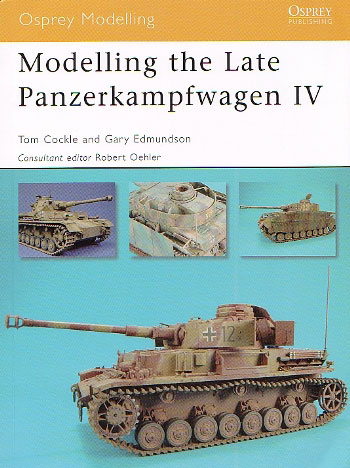|
|
|
|
Modelling the Late Panzerkampfwagen IV
Reviewed by Rob Baumgartner

Summary
| Publisher and Title | Osprey Modelling #38 Modelling the Late Panzerkampfwagen IV |
| Media and Contents: | 80 pages |
| Price: | USD$18.95 / GBP£12.95 available online from Osprey's website |
| Review Type: | First Read |
| Advantages: | Interesting selection of techniques, competent models, variety of subjects, easy to follow layout. |
| Disadvantages: | |
| Recommendation: | Recommended |
FirstLook
The Osprey modelling series has already dealt with the short
barreled versions of the Panzer IV. It’s only natural that the
authors continue with a look at the types that mounted the longer
75mm KwK 40 L/43 and L48 guns.
Tom Cockle and Gary Edmundson take the reader through a variety of
builds, each designed to illustrate different techniques to enhance
the chosen subjects.
This issue sees the continuation of the 80 page format and is
illustrated with over 200 colour photographs. These take the reader
on a step by step journey through the four selected builds,
culminating in an interesting “Gallery” section.
Kits from a number of different manufacturers are used as a basis
for these topics. Italeri, Tamiya and Dragon all feature, the latter
thanks to pre-production sprues as the kit wasn’t available to the
public at that time. All of the subjects are enhanced to some
degree, most with the help of photo etched parts, and a whole lot of
plastic.
After a brief introduction to the vehicle itself, the book looks at
the various tools and materials used for the projects. A Panzer IV
Ausf. F2 starts proceedings in Chapter 1 with a vehicle from 15.
Panzer Division in North Africa 1942.
Gary Edmundson details this model and explains his modifications,
including how to produce realistic weld seams. He conveys his
technique for painting and weathering as well as putting the tank in
a suitable vignette.
In chapter 2, Tom Cockle tackles an early Ausf. H from 4. Panzer
Division in Russia 1944. The highlight of this section is the way in
which the author manufactures his own “Schürzen” entirely out of
plastic card. “Zimmerit” is also discussed along with its
application and subsequent painting and detailing.
 The
Panzer IV Ausf. J is the subject of the next two sections and once
again these are contributed by Tom. The first is a vehicle from 11
Panzer Division in Bavaria 1945, the second being a member of 5
Panzer Division in East Prussia 1944. Both are extensively modified
with the latter receiving wire mesh Schürzen.
The
Panzer IV Ausf. J is the subject of the next two sections and once
again these are contributed by Tom. The first is a vehicle from 11
Panzer Division in Bavaria 1945, the second being a member of 5
Panzer Division in East Prussia 1944. Both are extensively modified
with the latter receiving wire mesh Schürzen.
As a result, an informative discussion on soldering photo etched
brass is included.
The “Gallery” features other Panzer IV projects and a colour card
gives an idea of what paint colours were used on these fighting
machines.
The book is rounded out with an appendix that directs the reader to
further information that can be found in museums, on the Internet,
and in other publications.
Conclusion
It is inevitable that sooner or
later, kits that are used in publications such as these will be
superseded. This book was written before Dragon’s newly tooled
Panzer IV hit the streets but that doesn’t mean the book is rendered
obsolete.
The authors are conveying techniques to the readers, not a step by
step diatribe on improving a particular kit. Thus the book is useful
for any late war Panzer IV and should prove to be a useful guide to
all those wanting to improve their skills.
Recommended
Thanks to
Osprey Publishing for the review sample.
